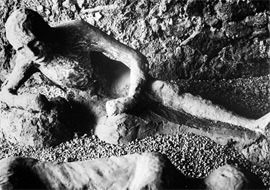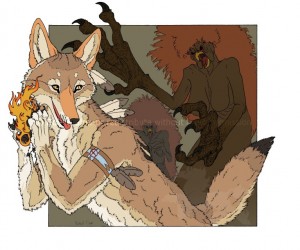Alright. This question might be hard, but I think it’s an awesome question so I’m going to give it a go.
Carlson’s publication makes a few thought-provoking points that challenge my pre-existing ideas about orality, literacy, Aboriginal culture and its relationship with Western culture. In particular, Carlson discusses the binary of “orality” versus “literacy” that has characterized Aboriginal and Western cultures since, well, Canadian colonization. Carlson begins by explaining the two different Aboriginal stories: Bertha Peters’ story and Harry Robinson’s story. Both of these stories, while they are inherently different, demonstrate the importance of literacy in Aboriginal culture and history.
Bertha Peters’ story is centralized around three chiefs that were taught to read and write by a Great Spirit. It was the three chiefs’ task to share this knowledge with the rest of their people, however they failed. As punishment these chiefs were transformed into stone. Peters states that because the chiefs’ people could not write down what they knew about themselves, their history, or their lives in general, the people of the three chiefs lost all of their knowledge (Carlson 43).
Robinson’s story talks about how literacy is stolen from Coyote. In Robinson’s story Coyote’s twin steals the piece of paper that enables the twins to become literate. Coyote eventually chases down his twin in London, and there they write the “black and white law”. Robinson states that literacy is “the key to accountability and the means of restoring interracial balance” and “is shown to be a powerful force, capable of precipitating transformations in people’s lives not unlike the transformative power associated with Coyote” (51 [emphasis added]). Robinson says that withheld Aboriginal literacy resulted in alienation, lost lands and lost culture.
Peters and Robinson argue the significance of literacy as a vital element of transformative life that was literally stolen (or withheld) from these Aboriginal cultures. For Peters’ story, literacy (or greed by literacy) is literally the reason the three chiefs are transformed into stone. In addition, the illiteracy of the chiefs’ people hinders their progression/transformation as a society. In this case, literacy both causes transformation and inhibits transformation.
The transformative stagnation of illiteracy that Peters describes is actually really interesting. Not only does this story address the reason Aboriginal cultures were left “illiterate”, but it also addresses the historical significance of literacy in Aboriginal culture. Peters and Robinson’s stories bridge the binary between orality and literacy that has forever distinguished my understanding of Aboriginal and Western culture. Carlson further conjoins these Aboriginal stories with the significance of literacy when he writes about the Stölo history of the Fraser River. This Stölo history tells the story of xe:xal:s, the transformers, who developed great transformative powers and punished three chiefs who “refused, or failed, to share their knowledge of literacy” (47). All of this helps explain how transformation relates to literacy itself, but how is transformation an “act of literacy”?
Carlson states earlier on that in the eyes of Western Culture, a culture without literacy is a culture without history. He moves on to the issue of validity in both Western and Aboriginal cultures. Carlson states that Western cultures use footnotes and references to validate their claims, and in the case of poor interpretation or inaccuracy, the Western scholar is seen as either a sloppy or a dishonest academic (57). In contrast, the Salish world relies upon memory, renditions of the narrative told, as well as the teller’s status and reputation to rate historical accuracy and validity of the speaker/their story. Similar to Western culture, inaccurate retellings of stories are also deemed sloppy and unreliable by Salish conveyors. In Aboriginal cultures there are frightening consequences for unreliable retellings and pose dangers to both the storyteller and the audience. Carlson discusses similar dangerous situations in Western culture with Nazism, where inaccurate historical retellings resulted in horrible disaster. By conveying the importance of validity in both Western society and Aboriginal society, Carlson is able to refute the Western claim that a society without literacy is a society without history, as he clearly conveys the existence of historical retellings and the significance of their accuracy/validity in Aboriginal society. Carlson goes on to then say that “transformation stories are as much, if not more, about permanency or stability as they are about the change from one state to another”. Why is this historical validity so important?
According to Carlson, just like Aboriginal stories are passed down from generation to generation, family names are also passed down. According to Carlson, pieces of the person(s) soul are attached to the name when it is passed down. Carlson writes “transformation stories are as much, if not more, about creating permanency or stability as they are about documenting the change from one state to another” (61). The name of the Transformers (Aboriginal peoples of the Fraser River) as well as the verb that is used to describe their transformative powers come from the same root work that describes the process of “marking” (61). Carlson writes “the Transformers leave their mark on the world through transformations… [they] are then understood and known through stories describing that act. Considered in this light, the ‘root word refers to inscription in the widest sense’” (61). Marking is therefore associated with the transformer, and according to Carlson “transforming [the chiefs] to stone was an act of literacy” (62). Robinson himself says before that literacy was powerful and could cause transformations in people’s lives, not unlike the power of the Transformers of the Stölo. Therefore, the act of transforming in its historical foundation is also the act of literacy.
I can’t help but draw connections between the bridged binary that Carlson builds between the worlds of orality and literacy with the creation story binary of Thomas King: The Aboriginal creation Story versus Genesis (the Western Creation Story). I’ll leave you all with this question: How do you think Thomas King bridges a similar binary? Maybe we’ll look at one of our questions from last week: why does Thomas King create this binary, and how does this relate to Carlson and the relationship between transformation and literacy as it relates to orality and literacy?
Works Cited
Carlson, Keith Thor. “Orality and Literacy: The ‘Black and White’ of Salish History.” Orality & Literacy: Reflectins Across Disciplines. Ed. Carlson, Kristina Fagna, & Natalia Khamemko-Frieson. Toronto: Uof Toronto P, 2011. 43-72.
Hanson, Erin. “The Indian Act.” The Indian Act. The University of British Columbia, n.d. Web. 18 June 2015.
King, Thomas. The Truth About Stories. Toronto: House of Anansi, 2003. Print.
Miller, J.R. “Residential Schools.” The Canadian Encyclopedia. Historica Canada, 10 Oct. 2012. Web. 18 June 2015.


Hi Hailey,
Thank you on your thoughts about literacy in segregating which cultures have history and which cultures do not. Your mention of family names reminded me that the culture’s artistic endeavours can occupy the vacancy left by the absence of written literature. Just as you pointed out, some people (like Peters) may say that the lack of literature leads to ignorance, while having written language can also be a way to manipulate and deceive. If we become overly reliant on receiving our information simply as lifeless and objective presentation of data, we become more isolated from our community. By contrast, a culture in steeped in oral tradition is likely more sophisticated in its reliance on the ethos and prestige of the individual who delivers the information. What would you say, in the face of 21st century upheavals of terrorism and globalization, is our best way forward. Should we continue to broaden our social circles tied together by empirical and scientific literature, or commit ourselves in smaller but tighter knit communities whose cohesion is defined by the trust built between individuals?
Hey Timothy!
I think that’s a really interesting question and it’s difficult to answer. I see pros and cons for both broadened and tightened social structures. I think that something that is important for our society to be able to move forward is for us to begin classifying ourselves as “citizens of the world” instead of citizens of any particular state/country. I feel like so many of our international issues are catalyzed by globalization, but more specifically because of the superficial intentions of globalization (e.g. the economic benefits). So many citizens of our world define themselves against “other” people, and international issues seem to be born out of misunderstandings/miscommunications across the same cultural boundaries that Lutz highlights.
Therefore, to answer your question I really think that there needs to be a healthy compromise between both large and small social circles. We need to learn to be more sensitive to other cultures, but at the same time we need to ensure these cultures are also sensitive to us. It’s an effort that needs to be made on all ends.
I hope that answers your question!
Hailey
🙂